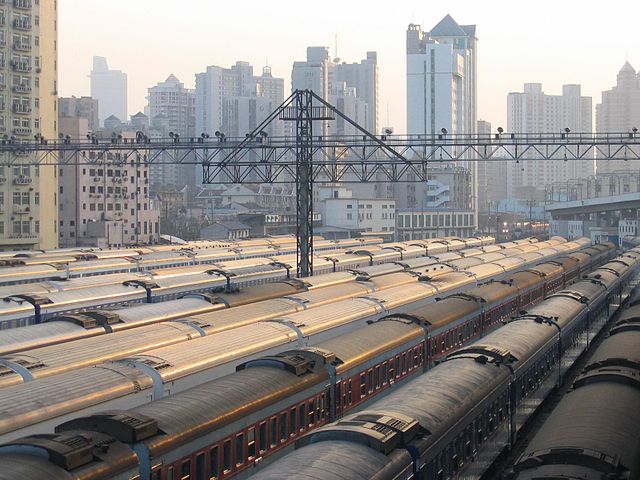Loading AI tools
Enclosed area designated for railways From Wikipedia, the free encyclopedia
A rail yard, railway yard, railroad yard (US) or simply yard, is a series of tracks in a rail network for storing, sorting, or loading and unloading rail vehicles and locomotives. Yards have many tracks in parallel for keeping rolling stock or unused locomotives stored off the main line, so that they do not obstruct the flow of traffic. Cars or wagons are moved around by specially designed yard switcher locomotives (US) or shunter locomotives (UK), a type of locomotive. Cars or wagons in a yard may be sorted by numerous categories, including railway company, loaded or unloaded, destination, car type, or whether they need repairs. Yards are normally built where there is a need to store rail vehicles while they are not being loaded or unloaded, or are waiting to be assembled into trains. Large yards may have a tower to control operations.[1]: 46
This article needs additional citations for verification. (February 2022) |


Many yards are located at strategic points on a main line. Main-line yards are often composed of an up yard and a down yard, linked to the associated direction of travel. There are different types of yards, and different parts within a yard, depending on how they are built.
For freight cars, the overall yard layout is typically designed around a principal switching (US term) or shunting (UK) technique:
In the case of all classification or sorting yards, human intelligence plays a primary role in setting a strategy for the switching operations; the fewer times coupling operations need to be made and the less distance traveled, the faster the operation, the better the strategy and the sooner the newly configured consist can be joined to its outbound train.


A large freight yard may include the following components:
Freight yards may have multiple industries adjacent to them where railroad cars are loaded or unloaded and then stored before they move on to their new destination.


Coach yards (American English) or stabling yards or carriage sidings (British English)[2] are used for sorting, storing and repairing passenger cars. These yards are located in metropolitan areas near large stations or terminals. An example of a major US coach yard is Sunnyside Yard in New York City, operated by Amtrak. Those that are principally used for storage, such as the West Side Yard in New York, are called "layup yards"[3] or "stabling yards." Coach yards are commonly flat yards because unladen passenger coaches are heavier than unladen freight carriages.
In the UK, a stabling point is a place where rail locomotives are parked while awaiting their next turn of duty.[4] A stabling point may be fitted with a fuelling point and other minor maintenance facilities. A good example of this was Newport's Godfrey Road stabling point, which has since been closed. Stabling sidings can be just a few roads or large complexes like Feltham Sidings. They are sometimes electrified with a third rail or OLE. An example of a stabling point with third rail would be Feltham marshalling yard which is being made into carriage sidings for the British Rail Class 701 EMU.[5][6][7]
Seamless Wikipedia browsing. On steroids.
Every time you click a link to Wikipedia, Wiktionary or Wikiquote in your browser's search results, it will show the modern Wikiwand interface.
Wikiwand extension is a five stars, simple, with minimum permission required to keep your browsing private, safe and transparent.